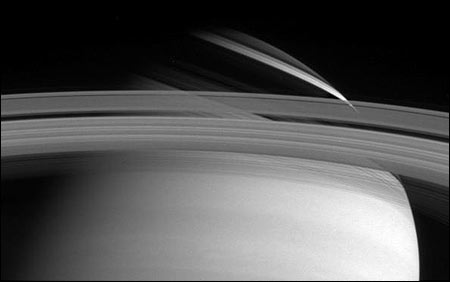Two interesting pieces of news have been received from Cassini in the last two days * you should expect more as the spacecraft approaches its destination
29.5.2004
By: Avi Blizovsky

Saturn's rings can cast a shadow over Saturn's northern hemisphere. Photo: NASA
Direct link to this page: https://www.hayadan.org.il/saturn270504.html
Cassini made an orbit change to pass by one of Saturn's moons on June 11
The Cassini spacecraft successfully changed its orbit so that it could pass by Saturn's outermost moon Phoebe on June 11 on its way to the ring planet. This is what NASA said on Friday.
Thursday's six-minute orbital maneuver was the first critical test of the spacecraft's complex propulsion system after nearly five years of inactivity, said Todd Barber, a Cassini propulsion engineer at NASA's Jet Propulsion Laboratory. "We made a correction to the form of the entrance to the route around Shebtai on June 30. said in a press release.
On that day, Cassini will need to burn its engines for 96 minutes to become the first Earth vehicle to enter orbit around Saturn.
The moon Phoebe, with its strange shape and dark surface, orbits Saturn in the opposite direction to that of most other bodies in the solar system. The scientists believe that the reverse motion indicates that it is an object from the distant Kuiper Belt that has been captured by Saturn's gravity.
Saturn's rings await the approach of the Cassini spacecraft
A new close-up of Saturn and its rings taken by the Cassini spacecraft reveals how close the American-European spacecraft is to its destination. Saturn's famous rings are now seen casting a shadow that appears as a series of parallel lines on Saturn's northern hemisphere.
The spacecraft is now 19 million kilometers from its destination, and has already traveled more than 3 billion kilometers since its launch in 1997.
In the picture you can see the F ring - the outermost ring and one of the thinnest. The image was taken on May 10 from a distance of 27.2 million kilometers from Saturn. The contrast in the image has been increased to help distinguish the small details.
Cassini will enter orbit around Saturn on June 30 and release the Huygens rover in January next year. Huygens will try to land on the oily days of Titan - the large moon of Thebes.
